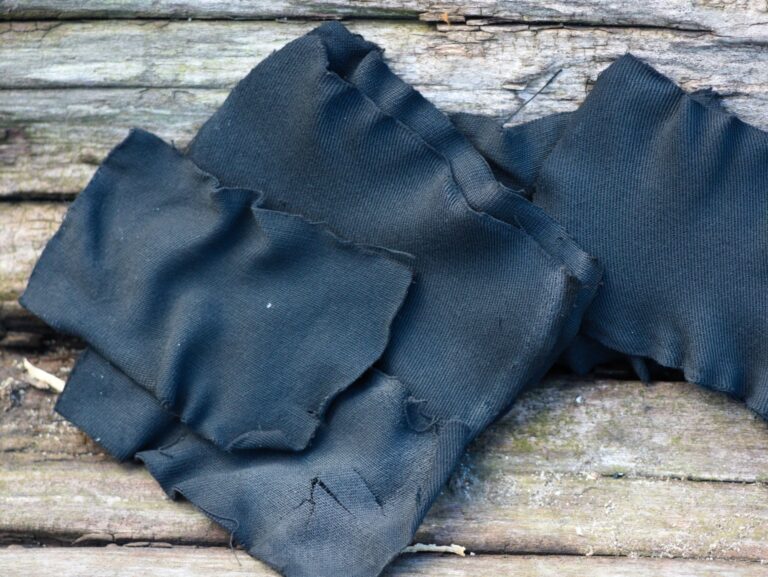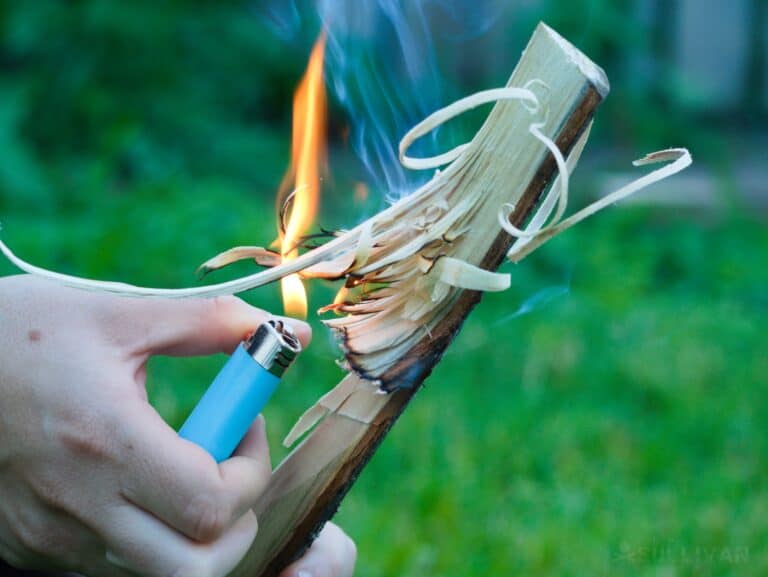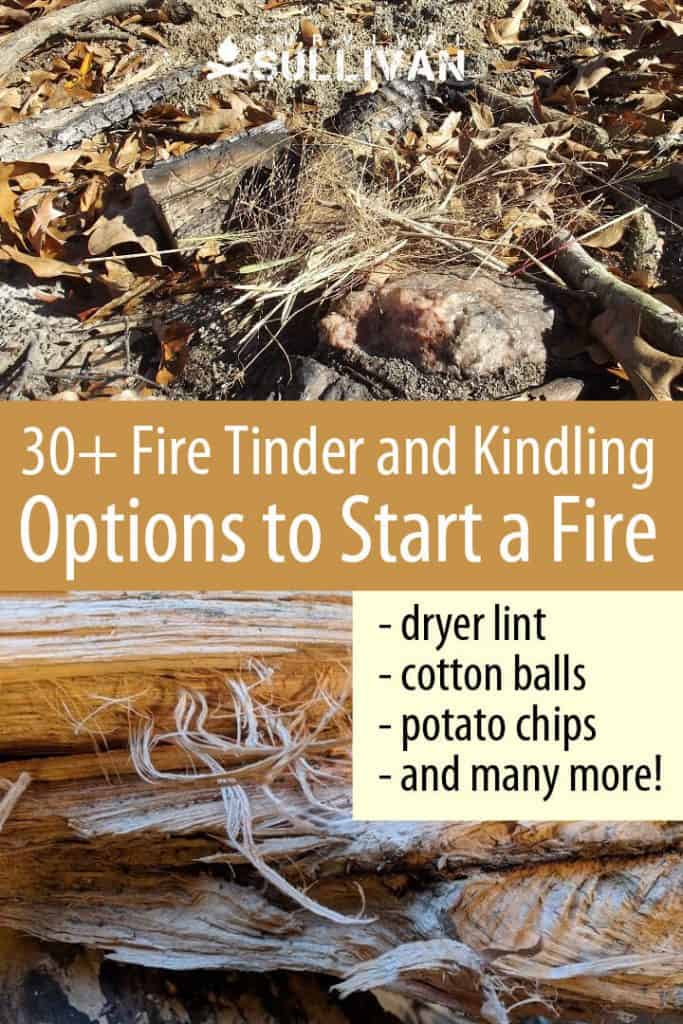Starting a fire is one of the most important survival skills anyone can learn. A fire means the difference between freezing and being warm.

It means the difference between eating a cold meal and a hot meal. It means being able to cook the meat you kill and the fish you catch. It means comfort and the difference between life and death.
Let me first say that this article isn’t about learning how to start a fire. This article is specifically about choosing that all important tinder and kindling so you have a chance of starting one and keeping it going.
When building a fire, there are three types of material you need to gather: tinder, kindling, and fuel. Fuel consists of larger pieces of wood, and kindling is typically smaller sticks.
Kindling is required to get your fuel lit, but tinder starts off the whole process. Tinder is defined as any material that will light from an ember or spark. In order for this to happen, it must either be very fluffy and dry or it must have some type of accelerant.
Table of Contents
The Importance of Tinder
Imagine it: You are finally getting to your campsite after a day of incredible arduousness. Unexpected rain, a challenging detour and some minor, annoying injuries to boot.
All you want to do is drop your pack, change out of those wet clothes and rack out. But a prepper’s job is never done. You have to clear the campsite and harvest some firewood, first.
So you ditch quickly setup your tent, drop your pack and pull your hatchet/axe from its sheath.
You find some suitable branches and small saplings which quickly fall to your increasingly exhausted efforts. A convenient nearby stump allows you to split the formidable oak into smaller chunks.
You lay the firewood together, strike a match and… nothing. The wood smolders but does not catch. You try another match, then another, blowing gently in a vain attempt to start the fire. Nothing.
You whip out your lighter and your heart soars, but only for a moment. The wood burns unevenly and smoky before sputtering out.
With fatigue weighing down your limbs like lead sleeves you try one last thing, your ferro rod. Scraping the back of your axe’s blade against the small rod a blast of sizzling sparks erupt into the wood, but no dice.
The sun is getting low now, too low, and a stiff breeze has picked up. You slump back in despair and prepare for a cold night, your energy and willpower spent.
Sound scary? Sound depressing?
You had better believe it, and if you don’t want to end up like the unfortunate prepper in this theoretical but all too real story you need to brush up your tinder and kindling game.
I’m not talking about the sleazy dating app: I am talking about the first stages of fuel you use to build a roaring and reliable campfire!
Whenever you are forced to work with substandard fuel, particularly in the form of freshly harvested wood with a high moisture content, utilizing tinder and kindling to best effect is imperative to get a fire going sustainably and reliably.
We will tell you everything you need to know in the rest of this article.
What is Tinder?
Before you can know how to find the right fire tinder, it is helpful to learn what these items are.
First of all, they are not the same thing. You cannot use the terms tinder and kindling interchangeably, just as you cannot use the items themselves interchangeably.
Tinder is a material used to ignite fires that catches fire really easily, such as straw, hay, dryer lint, or newspaper.
Tinder must be small enough to fit in the palm of your hand and be capable of being lit by a single spark or ember.
If you are using natural materials for tinder you will want to look for things like cedar bark, fatwood, dried moss, birch bark and shredded paper.
What is Kindling?
Kindling is the next size fuel up from tinder, and as such it needs to be smaller than your typical sticks used for firewood.
Kindling is used to keep a fire going once it has been initially lit, and can be made from materials like small branches, twigs or shavings.
It is important that you use dry kindling, as wet or green kindling will only serve to dampen your fire.
Now that we have gone over the basics of tinder and kindling, let’s take a look at some specific materials you can use for each.
Choosing Your Tinder
The first thing to know about tinder is that moisture is not your friend. What you want from your tinder is that it be dry and fluffy. The more moisture your potential tinder contains, the less likely it is to catch decently enough to ignite kindling, if it catches at all.
When searching for it, find the driest material possible, and if you are carrying it with you, take measures to keep it dry.
When it comes to selecting the best material for tinder, I will discuss the topic from two different angles. The first is what you can bring from home or what is manmade and will work well as tinder. The other is what you can find in the wild that will make good tinder.
Improvised Tinder
There are a number of different materials you can find laying around the house that make great tinder. Perhaps the most popular manmade tinder is newspaper, something that is used frequently to start fires in home fireplaces, woodstoves, and campfires.
Aside from newspaper (or other types of paper), the following make great manmade tinder:
- Dryer lint
- Cotton balls (coated in Vaseline if possible)
- Tampon fluff (from all-cotton tampons)
- Pieces of rubber tire
- Inner-tube rings from a bicycle
- #0000 steel wool
- Lint from cotton socks
- Potato chips
- Sawdust and melted wax (these can be premade and carried with you)
- Firestarter sticks
- Magnesium
- Char cloth
- Wetfire (a synthetic fire starter)
- Purell (makes a great fire starter)
- Trick birthday candles
Magnesium can be a great source of tinder if prepared properly. My ferro rod comes with a block of magnesium, but many hiking and camping tools are also made of magnesium.
You will need to shave off of the block or tool with a knife to get a fluffy pile of magnesium shavings. This should take a spark and give you a flame, but it will not last long so you have to move quickly.

Tinder Found in Nature
It’s really not an issue if you haven’t packed some material from home that you can use as tinder, because as long as the ground outside is dry, there are numerous materials you can use as tinder.
Even if it’s wet out, there are still tricks you can use to get something usable.
Dried leaves and grass work okay, but they really have to be roughed up to get them fluffy. A great way to find these sources already prepared is to hunt down a bird’s nest.
As birds build and use a nest over and over it creates a perfect tinder bundle for an ember. Another option for dry tinder is the fluff inside cattail heads. The exterior of the head will keep it dry in the rain, so popping one open can help in any weather.
In addition, dandelions can provide a good tinder source. If you gather a small bundle of the white fluffy seed heads they will readily take a spark.
Dried pine needles can be used for tinder but have to be broken and fluffed up. Another trick for tinder is to carry a small manual pencil sharpener with you.
You can create shavings from sticks and use it for tinder once you have a decent sized pile. Certain types of moss work great when dried. Tinder fungus is an excellent source provided by nature.
It can be found on fallen logs and will not only take an ember but can keep it going for hours.
Here is a list of things you can find in nature to use as tinder:
- Birch bark or small pieces of other tree bark
- Pinecones (smaller, lighter ones)
- Shaved wood
- Very tiny twigs
- Fluff from cattails
- Dry cattail leaves
- Dry pine needles
- Dry grass
- Dry leaves
- Tinder fungus
- Dandelion fluff (seeds)
- Milkweed fluff
- Fatwood (you can buy this if you’re not luck enough find it in the wild)
- Bird down
- Husk from hornets’ nest or beehive
- Straw
- Hanging moss
A note about fatwood. You can find fatwood in the old stumps of pine trees or other trees that produce a lot of resin, otherwise known as pitch.
This is particularly the case when the tree was cut down or otherwise broken. When the tree is cut down, the resin from the roots rises up into the stump and saturates the wood at the core, directly above the tap root.
Fatwood is the wood that is soaked with resin that gets left behind at the core of the stump as the other wood rots away. Depending on the size of the fatwood, it would make good tinder or good kindling.
What makes this so great? It’s due to the terpene in the resin, which is the primary ingredient in turpentine. Terpene is extremely flammable, which makes fatwood such a great fire starter.
Even when fatwood is wet, it only takes a spark to light it, and if you can make fatwood shavings, you will have some of the best tinder available. Now you just have to get out there and find those pine stumps!
Animal-Based Tinder
Animals can actually help you out with a few different tinder sources. Dried animal dung can be used just like tinder fungus, and many times it is easy to find in the wild.
Another option most people do not discuss are feathers. The fluffy interior feathers on most birds are perfect to ignite when dry. The next time you kill a bird in the wild, save that tinder.
If you kill a mammal in the wild, you can use some of the fur to create a tinder bundle. Just trim it off at skin level and create a bird’s nest shape to catch a spark.
Choosing Kindling
Kindling is larger than tinder, made to get a fire going for the short-term by being placed on top of the tinder.
The idea behind the use of kindling is that it is small enough to catch fire from the burning tinder and large enough to burn for a long enough time to allow the larger wood (fuel wood) to catch. It is also less likely than larger fuel wood to smother the small flames of the tinder.
When it comes to choosing the wood for your kindling, softwood, such as pine, is better than hardwood. Softwood will be easier to split and will burn more easily.
In, a pinch you can use cardboard if it’s available or you can roll up newspaper really tight and tie it in a knot. Put the knot near the flames of the tinder and allow it to catch on fire and it will burn for a while. Large pine cones can also be used.
Again, it is critical that your kindling is dry. Nothing defeats the creation of a fire like moisture. If you have wood that is wet, then you can split it and use the dry wood from the interior as kindling. Kindling is not very big in terms of size.
It is generally fairly small, thin twigs or sticks or larger wood splinters. You want your kindling to range in diameter from the size of a match to the size of a pencil. If you can’t snap it with your bare hands, then it’s too thick to effectively get your fire going.
Another option would be to use your knife to carve your own feather sticks.

Last but not least, while pine sap won’t work very well as tinder, it should work very well as kindling, as many have seen.
Accelerants
There are several accelerants that can be used by themselves or added to other material to make good tinder.
Any product with a high alcohol content can be added to tinder to get a fire going. I actually used an alcohol based poison ivy treatment to get a fire going in my very first survival challenge.
Hand sanitizer is a common product with a high alcohol content that works great for tinder. Sanitizing wipes are typically just a cloth soaked in sanitizer, so they get the job done as well.
You can find plenty of products in any garage to get a fire going. Gasoline, kerosene, and lighter fluid all work well as an additive for tinder. Be careful as the fumes can be explosive.
Most aerosol cans contain products that are flammable, and most bug spray makes for a good accelerant. WD40 is another product that is very common and can help you get it lit.
Any substances that are waxy or fatty can be of use. In the kitchen you can use lard or bacon grease to help get your tinder going.
You can also use chapstick, paraffin wax, or shoe polish to enhance your fire starting substances. I often carry bowstring wax when I have my crossbow or compound bow, and it works well when added to fluffy tinder.
Fire Assistance Products for Purchase
Finally, we come to the easiest way to get tinder… to buy it. I know it is sort of breaking the rules, but in a real survival situation you need every advantage you can get.
There are several tinder products that can be purchased to help start a fire. These products are especially helpful in wet or cold weather as most of your normal tinder may be soaked. All of these products work even when doused in water.
Disclosure: This post has links to 3rd party websites, so I may get a commission if you buy through those links. Survival Sullivan is a participant in the Amazon Services LLC Associates Program. As an Amazon Associate, I earn from qualifying purchases. See my full disclosure for more.
There are several versions of fire cubes available which are probably my favorite kind of artificial tinder. These are small waxy cubes that come in packs of 12 or more. Many of them are individually wrapped so you can just throw a few in your pocket.
One cube can be used for about four fires. You just shave off a small pile of shavings and light it with a single spark. Then cut a small chunk off and drop it in the flame.
This will stay lit for several minutes while you get your kindling going. It is windproof and will work in the pouring rain.
Over-the-Counter Tinder and Fire-Starters
The first option for starting a fire is using commercially available over-the-counter tinder and fire starters. This type of product can be found at most outdoor or camping stores, and usually comes in the form of small cubes, sticks or discs.
The advantages of these products are that they are easy to use and very reliable. All you have to do is light them up and place them under your kindling, and they will take care of the rest.
The main disadvantage of commercial fire starters is that they can be a bit pricey if you need to buy them in bulk. They also tend to come in environmentally unfriendly packaging, which can add to your waste output when travelling or camping.
One of the best on the market is the Blackbeard fire starter. Looking just like a giant cannon fuze, this rope-like tinder is wind and water proof, non-toxic, odorless and incredibly easy to use with a remarkable 4 hour burn time.
You can easily get 50+ ignitions from one stick! This is an ideal option for any survival kit or bug out bag.
Other popular choices are the UCO Stormproof Match Kit and the Coghlan’s Fire Sticks. The UCO kit comes with 25 wind and waterproof matches that are large enough to serve as your tinder once struck.
The Coghlan’s fire sticks are similarly easy to light and give off a large flame, making them perfect for starting fires in wet or windy conditions. They also come in a handy tin that can be used for storage or as a mini stove.
All of these options are great for starting fires, but they do have their drawbacks. First, they are all consumable items, so you will need to purchase more once you run out.
Second, aside from the Blackbeard fire starter and Fire Sticks, they can be difficult to light in wet or windy conditions.
Final Tips
Finding the right tinder and kindling will mean the difference between having a fire and not having a fire. Simply put, if you don’t have either of these, you can have all the fuel wood you want and you won’t get a fire going.
Here are some final tips to help ensure you have good functional tinder and kindling:
- Carry some on you (natural or man-made) in a sealed, waterproof container, such as a 35 mm film container or a Ziploc bag
- Make use of your knife to turn dry sticks and bark into a powder or to shred paper
- Whatever you think you need for tinder and kindling, collect twice that amount because you’ll most likely go through it faster than you anticipate; if you run out too soon, then you won’t have a fire
It is very important that you practice your skills at building a fire and these skills include the selection and gathering of tinder and kindling. Like all aspects of prepping, this should be practiced ahead of time.
Try out different types of tinder with your various fire starting methods to determine which works best and is the most practical based on the most likely survival scenario you’ll be in.
The same goes for kindling. Practice gathering different types of wood, different sizes, and varying levels of moisture.
Test them out to determine what types of wood in your area make the best kindling and learn how to gauge the moisture level of wood and split wood to make kindling.
Try making a fire with wet kindling (and wet tinder, too) and see how adept you can get at getting a fire started in the toughest of conditions.
The more familiar you become with the different types of tinder and the different types of wood the better off you and your loved ones will be when the time comes that you need these skills to survive.
Good luck lighting those fires!


An urban prepper and rural wannabe, Karen has been working as a freelance writer for a decade and prepping for about half that time. She has gathered a wealth of knowledge on preparing for SHTF, but there is always more to learn and she has a passion for gathering and sharing that knowledge with other like-minded folk. Karen lives in London, Canada with her two children and plethora of cats.

There is a small (fits in a pocket), easy to use (a 5-year old kid can use it) inexpensive, works with wet wood, and super easy device that can generate a lot of tinder to start a fire.
What is this marvel of technology?
It’s called a pencil sharpener.
All you do is find a pencil-sized stick (I gotta tell you, the world is full of pencil sized sticks), stick it in it and turn it and wood shavings fall out. It also works with wet wood as only the outside of a stick is wet. The inside is dry.
Why in the world would you burn rubber?